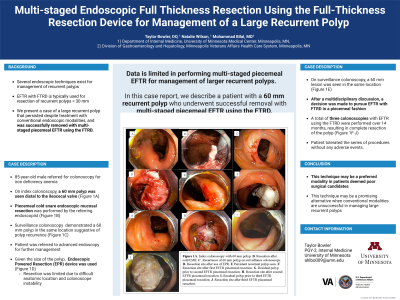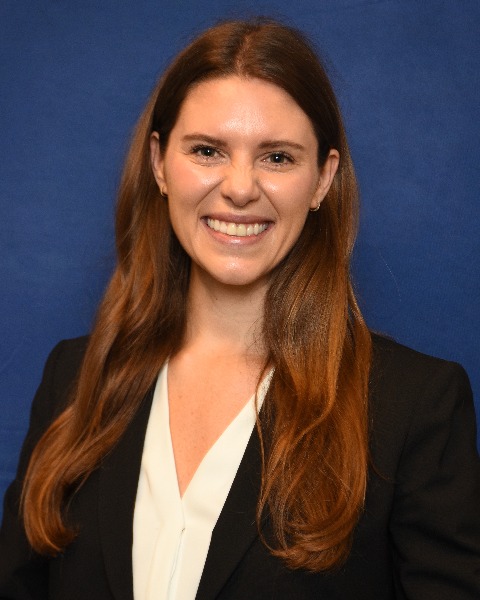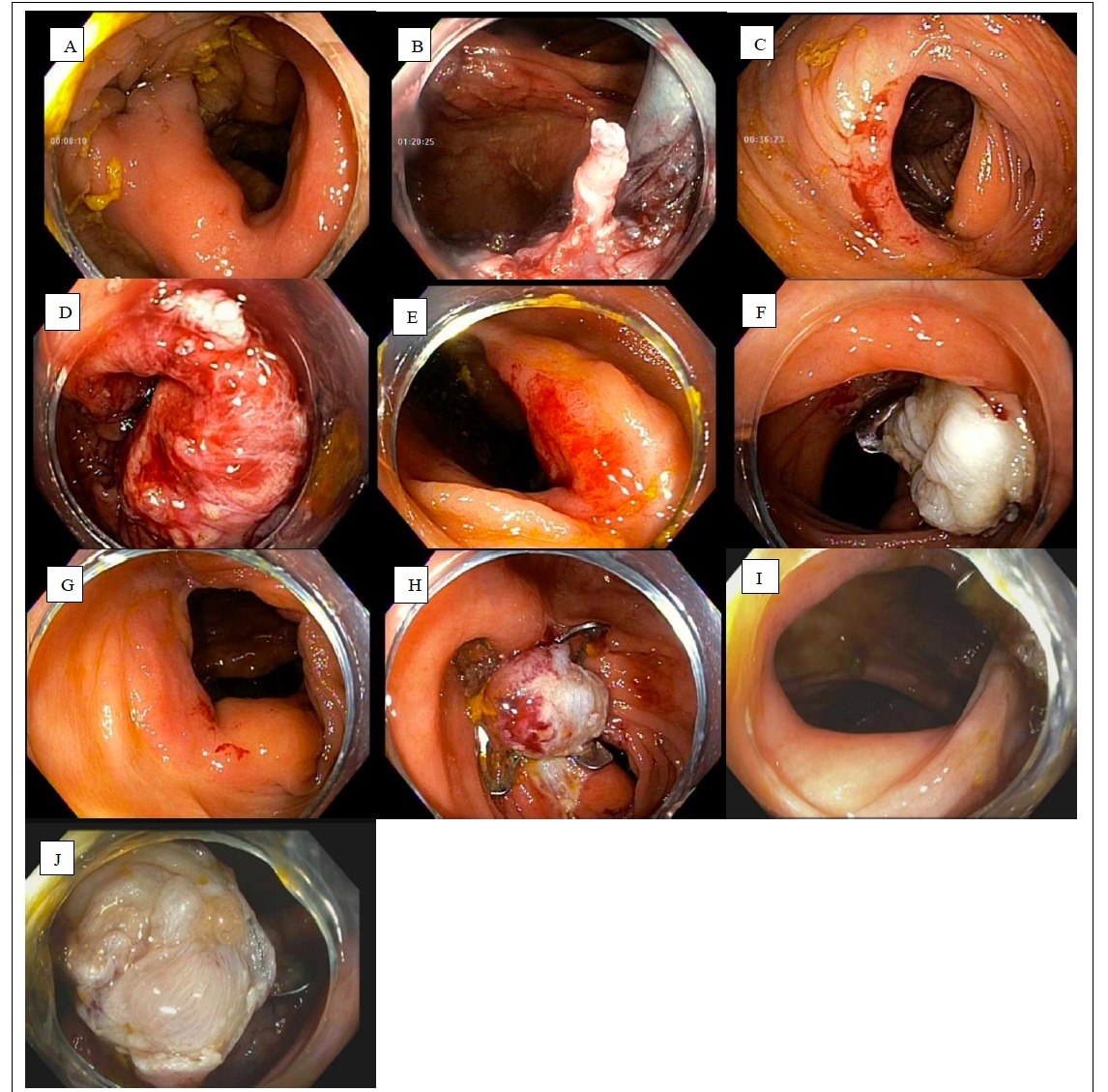Monday Poster Session
Category: General Endoscopy
P2407 - Multi-Staged Endoscopic Full Thickness Resection Using the Full-Thickness Resection Device for Management of a Large Recurrent Polyp
Monday, October 28, 2024
10:30 AM - 4:00 PM ET
Location: Exhibit Hall E

Has Audio

Taylor Bowler, DO
University of Minnesota Medical Center
Minneapolis, MN
Presenting Author(s)
Taylor Bowler, DO1, Natalie Wilson, MD2, Mohammad Bilal, MD3
1University of Minnesota Medical Center, Minneapolis, MN; 2University of Minnesota, Minneapolis, MN; 3University of Minnesota and Minneapolis VA Health Care System, Minneapolis, MN
Introduction: Several endoscopic techniques exist for management of recurrent polyps after initial endoscopic resection. Endoscopic full-thickness resection (EFTR) using a full thickness resection device (FTRD) is used for resection of recurrent or residual polyps, however is still limited to polyps up to 30 mm in size. While few studies have demonstrated a hybrid approach with endoscopic submucosal dissection and EFTR to overcome these size limitations, data is limited in performing multi-staged piecemeal EFTR for management of large recurrent polyps. Here, we describe a patient with a 60 mm persistent recurrent polyp who underwent successful polyp removal with multi-staged piecemeal EFTR using the FTRD.
Case Description/Methods: An 85-year-old male was referred for colonoscopy for evaluation of iron deficiency anemia. On index colonoscopy, a 60 mm polyp was seen immediately distal to the ileocecal valve (Figure 1A). Piecemeal cold snare endoscopic mucosal resection was performed by the referring endoscopist (Figure 1B). Surveillance colonoscopy 6 months later demonstrated a 60 mm polyp in the same location suggestive of polyp recurrence (Figure 1C). The patient was referred to advanced endoscopy for further management. Given the size of the polyp, the decision was made to use the Endoscopic Powered Resection (EPR) device (Figure 1D). However, resection was limited due to difficult anatomic location and colonoscope instability. Cold snare with cold/hot avulsion was used to remove the remaining polyp, and hybrid-argon plasma was subsequently performed after all visible adenoma was removed. On surveillance colonoscopy 6 months later, a 60 mm lesion was seen in the same location suggestive of recurrence (Figure 1E). After a multidisciplinary discussion, the decision was made to pursue EFTR with FTRD in a piecemeal fashion due to the large size, technically challenging location, and recurrence despite two prior endoscopic resections. A total of three colonoscopies with EFTR using the FTRD were performed over 14 months, resulting in complete resection of the polyp (Figure 1F-H). The patient tolerated the series of procedures without any adverse events.
Discussion: This report demonstrates that serial EFTR using the FTRD is a useful tool for resection of large recurrent or fibrotic polyps in anatomically difficult locations not amenable to conventional methods for managing polyp recurrence.

Disclosures:
Taylor Bowler, DO1, Natalie Wilson, MD2, Mohammad Bilal, MD3. P2407 - Multi-Staged Endoscopic Full Thickness Resection Using the Full-Thickness Resection Device for Management of a Large Recurrent Polyp, ACG 2024 Annual Scientific Meeting Abstracts. Philadelphia, PA: American College of Gastroenterology.
1University of Minnesota Medical Center, Minneapolis, MN; 2University of Minnesota, Minneapolis, MN; 3University of Minnesota and Minneapolis VA Health Care System, Minneapolis, MN
Introduction: Several endoscopic techniques exist for management of recurrent polyps after initial endoscopic resection. Endoscopic full-thickness resection (EFTR) using a full thickness resection device (FTRD) is used for resection of recurrent or residual polyps, however is still limited to polyps up to 30 mm in size. While few studies have demonstrated a hybrid approach with endoscopic submucosal dissection and EFTR to overcome these size limitations, data is limited in performing multi-staged piecemeal EFTR for management of large recurrent polyps. Here, we describe a patient with a 60 mm persistent recurrent polyp who underwent successful polyp removal with multi-staged piecemeal EFTR using the FTRD.
Case Description/Methods: An 85-year-old male was referred for colonoscopy for evaluation of iron deficiency anemia. On index colonoscopy, a 60 mm polyp was seen immediately distal to the ileocecal valve (Figure 1A). Piecemeal cold snare endoscopic mucosal resection was performed by the referring endoscopist (Figure 1B). Surveillance colonoscopy 6 months later demonstrated a 60 mm polyp in the same location suggestive of polyp recurrence (Figure 1C). The patient was referred to advanced endoscopy for further management. Given the size of the polyp, the decision was made to use the Endoscopic Powered Resection (EPR) device (Figure 1D). However, resection was limited due to difficult anatomic location and colonoscope instability. Cold snare with cold/hot avulsion was used to remove the remaining polyp, and hybrid-argon plasma was subsequently performed after all visible adenoma was removed. On surveillance colonoscopy 6 months later, a 60 mm lesion was seen in the same location suggestive of recurrence (Figure 1E). After a multidisciplinary discussion, the decision was made to pursue EFTR with FTRD in a piecemeal fashion due to the large size, technically challenging location, and recurrence despite two prior endoscopic resections. A total of three colonoscopies with EFTR using the FTRD were performed over 14 months, resulting in complete resection of the polyp (Figure 1F-H). The patient tolerated the series of procedures without any adverse events.
Discussion: This report demonstrates that serial EFTR using the FTRD is a useful tool for resection of large recurrent or fibrotic polyps in anatomically difficult locations not amenable to conventional methods for managing polyp recurrence.

Figure: Figure 1A. Index colonoscopy with 60 mm polyp. B. Resection after cold EMR. C. Recurrence of 60 mm polyp on surveillance colonoscopy. D. Resection site after use of EPR. E Persistent recurrent polyp seen. F. Resection site after first EFTR piecemeal resection. G. Residual polyp prior to second EFTR piecemeal resection. H. Resection site after second EFTR piecemeal resection. I. Residual polyp prior to third EFTR piecemeal resection. J. Resection site after third EFTR piecemeal resection.
Disclosures:
Taylor Bowler indicated no relevant financial relationships.
Natalie Wilson indicated no relevant financial relationships.
Mohammad Bilal: Boston Scientific – Consultant.
Taylor Bowler, DO1, Natalie Wilson, MD2, Mohammad Bilal, MD3. P2407 - Multi-Staged Endoscopic Full Thickness Resection Using the Full-Thickness Resection Device for Management of a Large Recurrent Polyp, ACG 2024 Annual Scientific Meeting Abstracts. Philadelphia, PA: American College of Gastroenterology.
